NUR4201: Ideal Nursing Unit - Primary Healthcare and Staffing Plan
VerifiedAdded on 2023/06/12
|5
|1157
|252
Report
AI Summary
This report outlines the implementation of a primary healthcare model within a small unit hospital, emphasizing the importance of a dedicated nurse responsible for patient care and the necessity of a strong therapeutic relationship. It details the composition of the healthcare unit, including physicians, nurses, and other essential staff, and discusses future staffing needs, recruitment strategies, and optimal staffing ratios. The report further addresses staff responsibilities, schedules, and the importance of mentorship and team building. It concludes by emphasizing strategies for staff motivation, work-life balance, and open communication to foster a positive and productive work environment. Desklib offers a wealth of similar solved assignments and past papers for students.
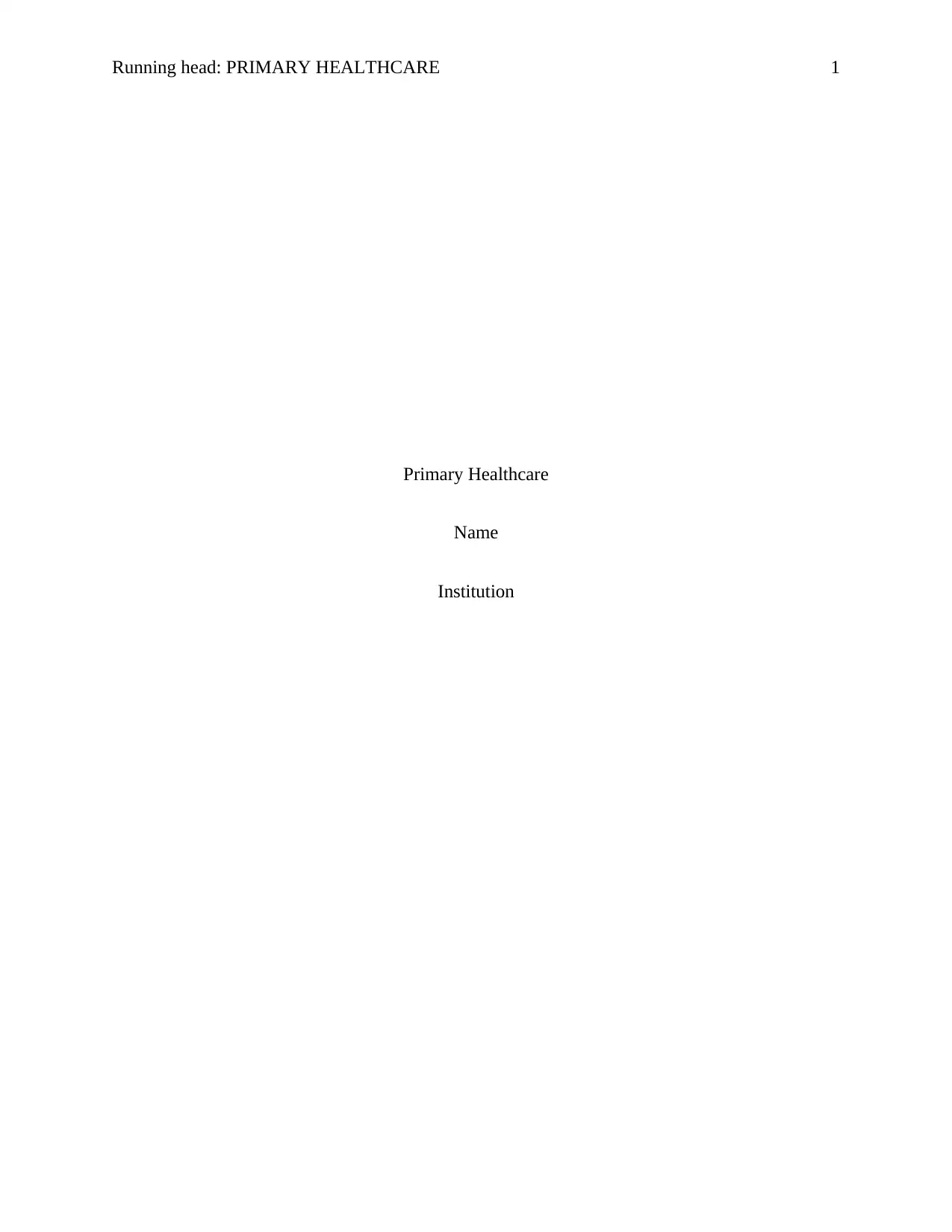
Running head: PRIMARY HEALTHCARE 1
Primary Healthcare
Name
Institution
Primary Healthcare
Name
Institution
Paraphrase This Document
Need a fresh take? Get an instant paraphrase of this document with our AI Paraphraser
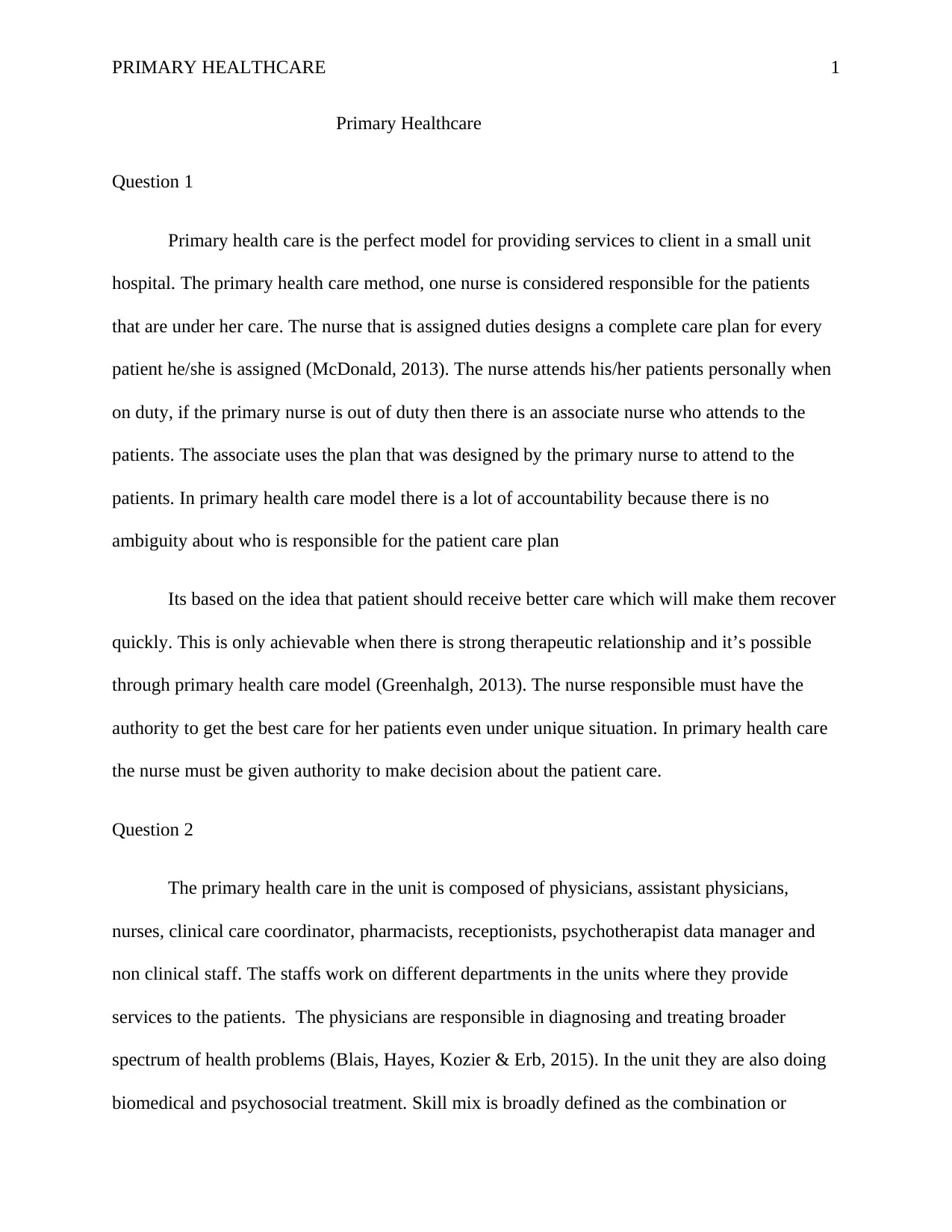
PRIMARY HEALTHCARE 1
Primary Healthcare
Question 1
Primary health care is the perfect model for providing services to client in a small unit
hospital. The primary health care method, one nurse is considered responsible for the patients
that are under her care. The nurse that is assigned duties designs a complete care plan for every
patient he/she is assigned (McDonald, 2013). The nurse attends his/her patients personally when
on duty, if the primary nurse is out of duty then there is an associate nurse who attends to the
patients. The associate uses the plan that was designed by the primary nurse to attend to the
patients. In primary health care model there is a lot of accountability because there is no
ambiguity about who is responsible for the patient care plan
Its based on the idea that patient should receive better care which will make them recover
quickly. This is only achievable when there is strong therapeutic relationship and it’s possible
through primary health care model (Greenhalgh, 2013). The nurse responsible must have the
authority to get the best care for her patients even under unique situation. In primary health care
the nurse must be given authority to make decision about the patient care.
Question 2
The primary health care in the unit is composed of physicians, assistant physicians,
nurses, clinical care coordinator, pharmacists, receptionists, psychotherapist data manager and
non clinical staff. The staffs work on different departments in the units where they provide
services to the patients. The physicians are responsible in diagnosing and treating broader
spectrum of health problems (Blais, Hayes, Kozier & Erb, 2015). In the unit they are also doing
biomedical and psychosocial treatment. Skill mix is broadly defined as the combination or
Primary Healthcare
Question 1
Primary health care is the perfect model for providing services to client in a small unit
hospital. The primary health care method, one nurse is considered responsible for the patients
that are under her care. The nurse that is assigned duties designs a complete care plan for every
patient he/she is assigned (McDonald, 2013). The nurse attends his/her patients personally when
on duty, if the primary nurse is out of duty then there is an associate nurse who attends to the
patients. The associate uses the plan that was designed by the primary nurse to attend to the
patients. In primary health care model there is a lot of accountability because there is no
ambiguity about who is responsible for the patient care plan
Its based on the idea that patient should receive better care which will make them recover
quickly. This is only achievable when there is strong therapeutic relationship and it’s possible
through primary health care model (Greenhalgh, 2013). The nurse responsible must have the
authority to get the best care for her patients even under unique situation. In primary health care
the nurse must be given authority to make decision about the patient care.
Question 2
The primary health care in the unit is composed of physicians, assistant physicians,
nurses, clinical care coordinator, pharmacists, receptionists, psychotherapist data manager and
non clinical staff. The staffs work on different departments in the units where they provide
services to the patients. The physicians are responsible in diagnosing and treating broader
spectrum of health problems (Blais, Hayes, Kozier & Erb, 2015). In the unit they are also doing
biomedical and psychosocial treatment. Skill mix is broadly defined as the combination or
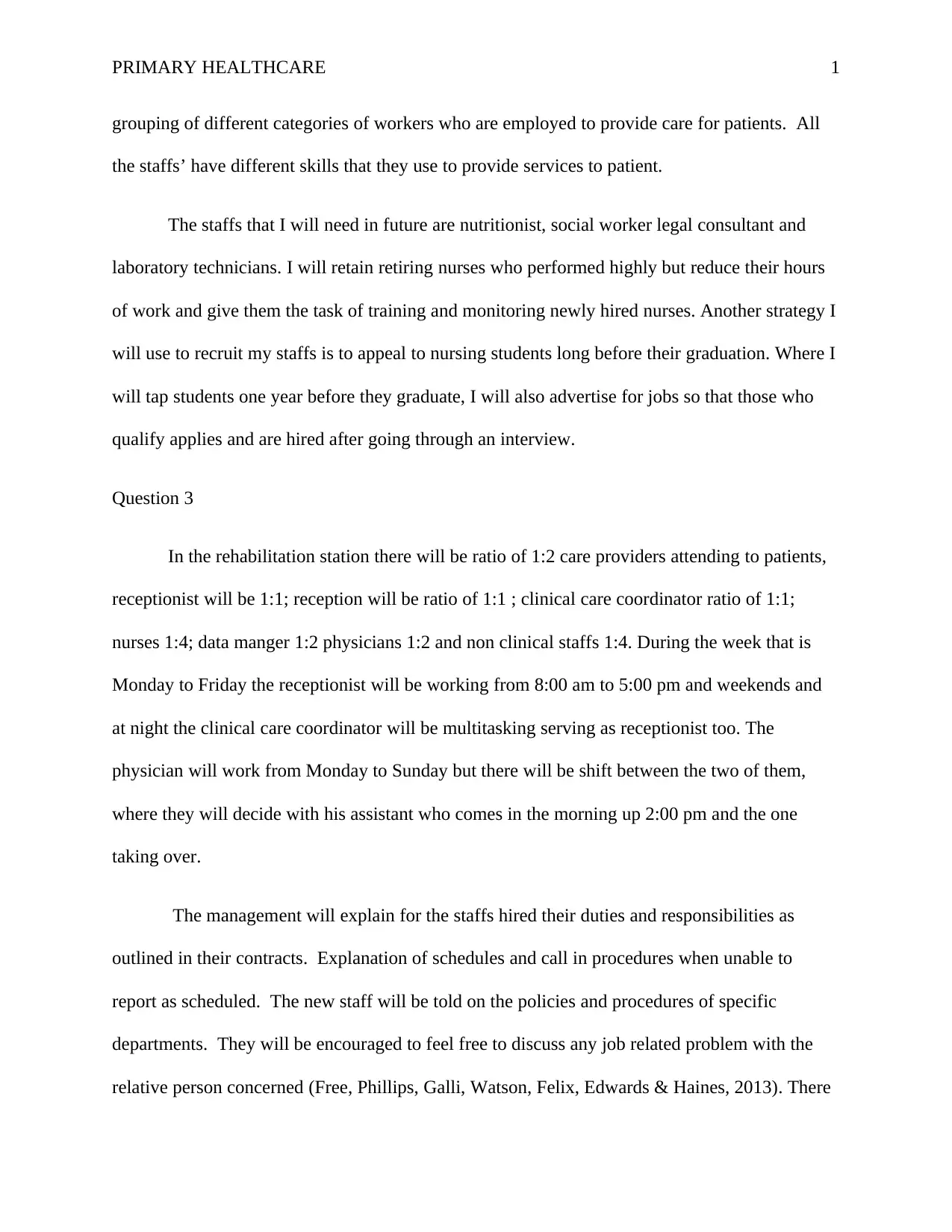
PRIMARY HEALTHCARE 1
grouping of different categories of workers who are employed to provide care for patients. All
the staffs’ have different skills that they use to provide services to patient.
The staffs that I will need in future are nutritionist, social worker legal consultant and
laboratory technicians. I will retain retiring nurses who performed highly but reduce their hours
of work and give them the task of training and monitoring newly hired nurses. Another strategy I
will use to recruit my staffs is to appeal to nursing students long before their graduation. Where I
will tap students one year before they graduate, I will also advertise for jobs so that those who
qualify applies and are hired after going through an interview.
Question 3
In the rehabilitation station there will be ratio of 1:2 care providers attending to patients,
receptionist will be 1:1; reception will be ratio of 1:1 ; clinical care coordinator ratio of 1:1;
nurses 1:4; data manger 1:2 physicians 1:2 and non clinical staffs 1:4. During the week that is
Monday to Friday the receptionist will be working from 8:00 am to 5:00 pm and weekends and
at night the clinical care coordinator will be multitasking serving as receptionist too. The
physician will work from Monday to Sunday but there will be shift between the two of them,
where they will decide with his assistant who comes in the morning up 2:00 pm and the one
taking over.
The management will explain for the staffs hired their duties and responsibilities as
outlined in their contracts. Explanation of schedules and call in procedures when unable to
report as scheduled. The new staff will be told on the policies and procedures of specific
departments. They will be encouraged to feel free to discuss any job related problem with the
relative person concerned (Free, Phillips, Galli, Watson, Felix, Edwards & Haines, 2013). There
grouping of different categories of workers who are employed to provide care for patients. All
the staffs’ have different skills that they use to provide services to patient.
The staffs that I will need in future are nutritionist, social worker legal consultant and
laboratory technicians. I will retain retiring nurses who performed highly but reduce their hours
of work and give them the task of training and monitoring newly hired nurses. Another strategy I
will use to recruit my staffs is to appeal to nursing students long before their graduation. Where I
will tap students one year before they graduate, I will also advertise for jobs so that those who
qualify applies and are hired after going through an interview.
Question 3
In the rehabilitation station there will be ratio of 1:2 care providers attending to patients,
receptionist will be 1:1; reception will be ratio of 1:1 ; clinical care coordinator ratio of 1:1;
nurses 1:4; data manger 1:2 physicians 1:2 and non clinical staffs 1:4. During the week that is
Monday to Friday the receptionist will be working from 8:00 am to 5:00 pm and weekends and
at night the clinical care coordinator will be multitasking serving as receptionist too. The
physician will work from Monday to Sunday but there will be shift between the two of them,
where they will decide with his assistant who comes in the morning up 2:00 pm and the one
taking over.
The management will explain for the staffs hired their duties and responsibilities as
outlined in their contracts. Explanation of schedules and call in procedures when unable to
report as scheduled. The new staff will be told on the policies and procedures of specific
departments. They will be encouraged to feel free to discuss any job related problem with the
relative person concerned (Free, Phillips, Galli, Watson, Felix, Edwards & Haines, 2013). There
⊘ This is a preview!⊘
Do you want full access?
Subscribe today to unlock all pages.

Trusted by 1+ million students worldwide
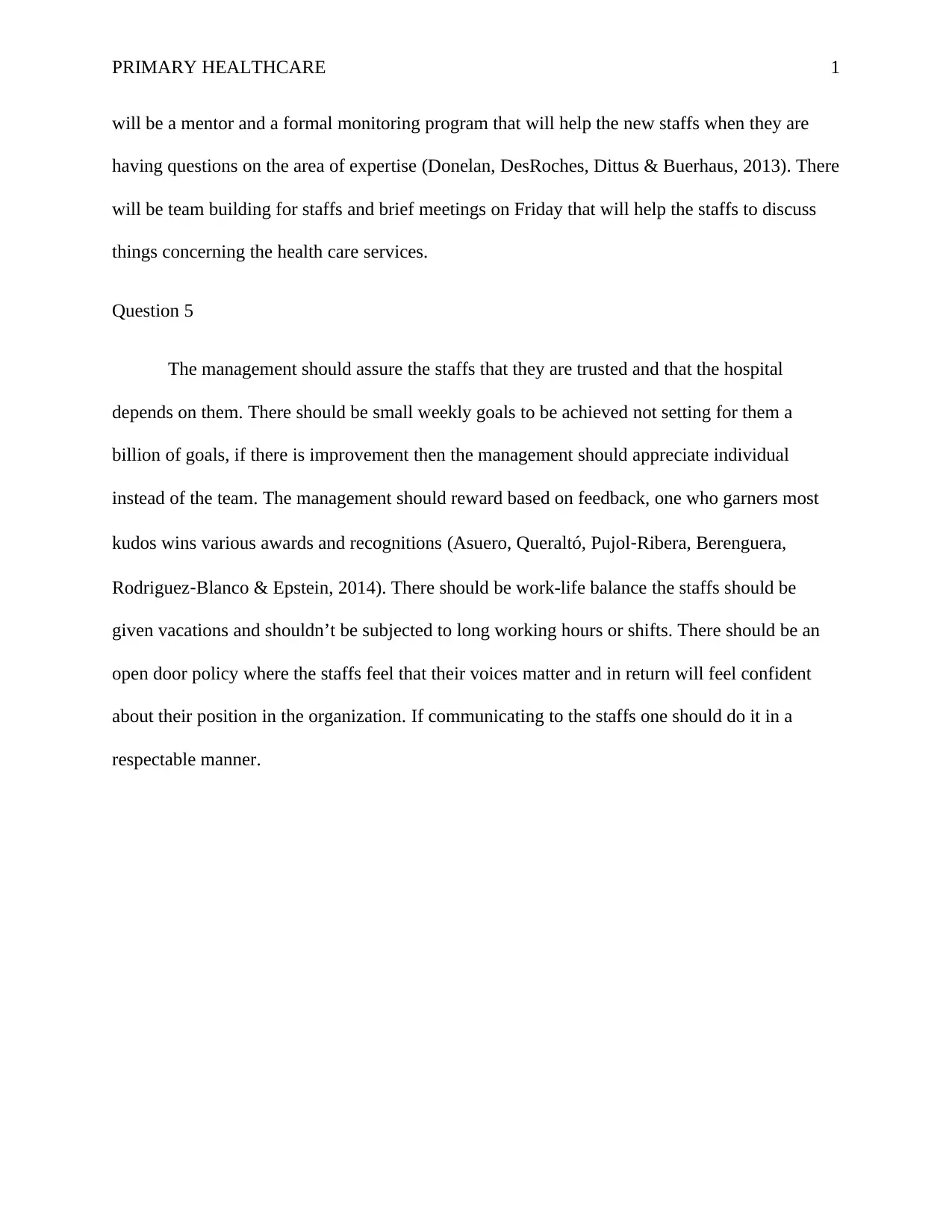
PRIMARY HEALTHCARE 1
will be a mentor and a formal monitoring program that will help the new staffs when they are
having questions on the area of expertise (Donelan, DesRoches, Dittus & Buerhaus, 2013). There
will be team building for staffs and brief meetings on Friday that will help the staffs to discuss
things concerning the health care services.
Question 5
The management should assure the staffs that they are trusted and that the hospital
depends on them. There should be small weekly goals to be achieved not setting for them a
billion of goals, if there is improvement then the management should appreciate individual
instead of the team. The management should reward based on feedback, one who garners most
kudos wins various awards and recognitions (Asuero, Queraltó, Pujol‐Ribera, Berenguera,
Rodriguez‐Blanco & Epstein, 2014). There should be work-life balance the staffs should be
given vacations and shouldn’t be subjected to long working hours or shifts. There should be an
open door policy where the staffs feel that their voices matter and in return will feel confident
about their position in the organization. If communicating to the staffs one should do it in a
respectable manner.
will be a mentor and a formal monitoring program that will help the new staffs when they are
having questions on the area of expertise (Donelan, DesRoches, Dittus & Buerhaus, 2013). There
will be team building for staffs and brief meetings on Friday that will help the staffs to discuss
things concerning the health care services.
Question 5
The management should assure the staffs that they are trusted and that the hospital
depends on them. There should be small weekly goals to be achieved not setting for them a
billion of goals, if there is improvement then the management should appreciate individual
instead of the team. The management should reward based on feedback, one who garners most
kudos wins various awards and recognitions (Asuero, Queraltó, Pujol‐Ribera, Berenguera,
Rodriguez‐Blanco & Epstein, 2014). There should be work-life balance the staffs should be
given vacations and shouldn’t be subjected to long working hours or shifts. There should be an
open door policy where the staffs feel that their voices matter and in return will feel confident
about their position in the organization. If communicating to the staffs one should do it in a
respectable manner.
Paraphrase This Document
Need a fresh take? Get an instant paraphrase of this document with our AI Paraphraser
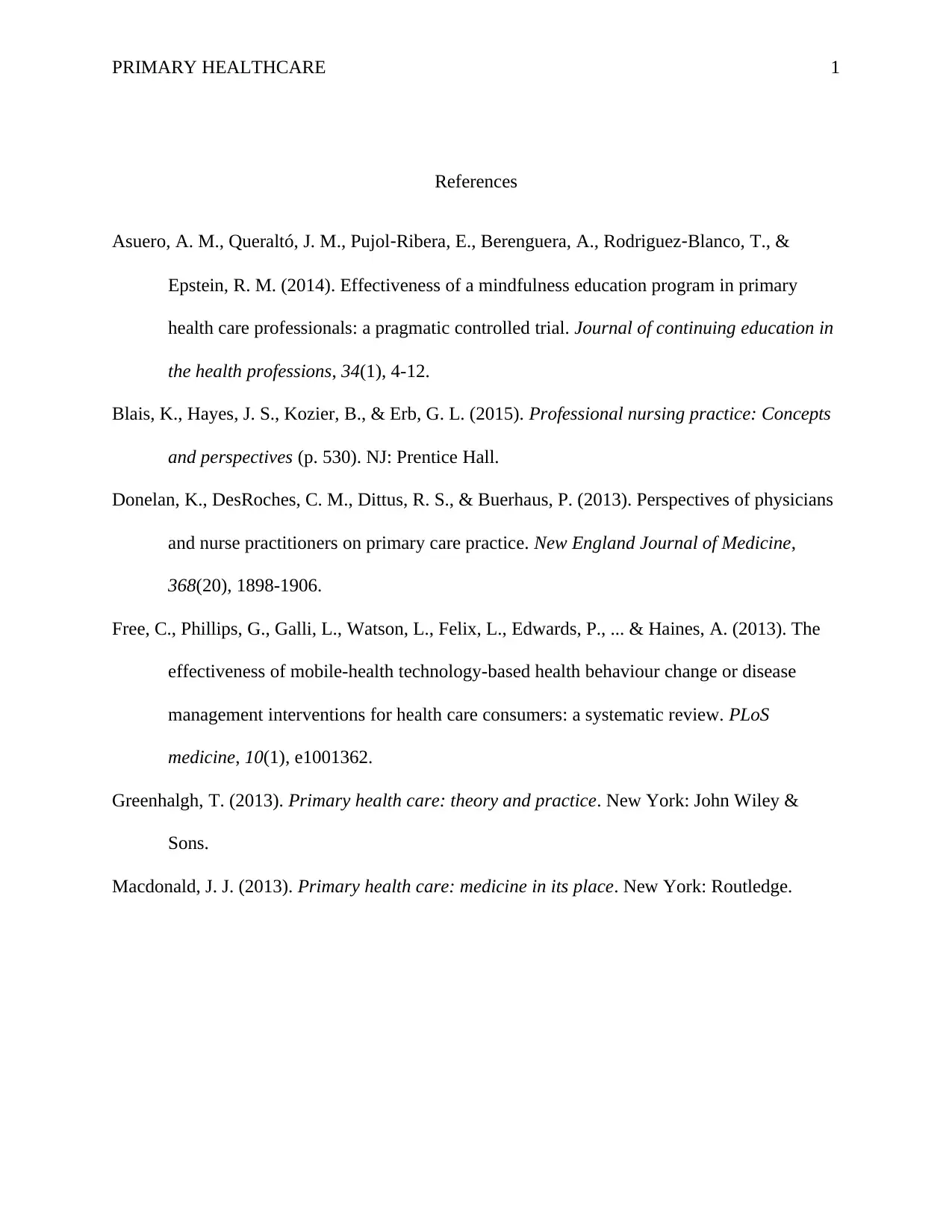
PRIMARY HEALTHCARE 1
References
Asuero, A. M., Queraltó, J. M., Pujol‐Ribera, E., Berenguera, A., Rodriguez‐Blanco, T., &
Epstein, R. M. (2014). Effectiveness of a mindfulness education program in primary
health care professionals: a pragmatic controlled trial. Journal of continuing education in
the health professions, 34(1), 4-12.
Blais, K., Hayes, J. S., Kozier, B., & Erb, G. L. (2015). Professional nursing practice: Concepts
and perspectives (p. 530). NJ: Prentice Hall.
Donelan, K., DesRoches, C. M., Dittus, R. S., & Buerhaus, P. (2013). Perspectives of physicians
and nurse practitioners on primary care practice. New England Journal of Medicine,
368(20), 1898-1906.
Free, C., Phillips, G., Galli, L., Watson, L., Felix, L., Edwards, P., ... & Haines, A. (2013). The
effectiveness of mobile-health technology-based health behaviour change or disease
management interventions for health care consumers: a systematic review. PLoS
medicine, 10(1), e1001362.
Greenhalgh, T. (2013). Primary health care: theory and practice. New York: John Wiley &
Sons.
Macdonald, J. J. (2013). Primary health care: medicine in its place. New York: Routledge.
References
Asuero, A. M., Queraltó, J. M., Pujol‐Ribera, E., Berenguera, A., Rodriguez‐Blanco, T., &
Epstein, R. M. (2014). Effectiveness of a mindfulness education program in primary
health care professionals: a pragmatic controlled trial. Journal of continuing education in
the health professions, 34(1), 4-12.
Blais, K., Hayes, J. S., Kozier, B., & Erb, G. L. (2015). Professional nursing practice: Concepts
and perspectives (p. 530). NJ: Prentice Hall.
Donelan, K., DesRoches, C. M., Dittus, R. S., & Buerhaus, P. (2013). Perspectives of physicians
and nurse practitioners on primary care practice. New England Journal of Medicine,
368(20), 1898-1906.
Free, C., Phillips, G., Galli, L., Watson, L., Felix, L., Edwards, P., ... & Haines, A. (2013). The
effectiveness of mobile-health technology-based health behaviour change or disease
management interventions for health care consumers: a systematic review. PLoS
medicine, 10(1), e1001362.
Greenhalgh, T. (2013). Primary health care: theory and practice. New York: John Wiley &
Sons.
Macdonald, J. J. (2013). Primary health care: medicine in its place. New York: Routledge.
1 out of 5
Related Documents
Your All-in-One AI-Powered Toolkit for Academic Success.
+13062052269
info@desklib.com
Available 24*7 on WhatsApp / Email
![[object Object]](/_next/static/media/star-bottom.7253800d.svg)
Unlock your academic potential
Copyright © 2020–2025 A2Z Services. All Rights Reserved. Developed and managed by ZUCOL.





